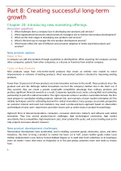Part 8: Creating successful long-term
growth
Chapter 20: Introducing new marketing offerings
Discussion questions:
1. What challenges does a company face in developing new products and services?
2. What organizational structures and processes do managers use to oversee new-product development?
3. What are the main stages in developing new products and services?
4. What is the best way to manage the new-product development process?
5. What factors affect the rate of diffusion and consumer adoption of newly launched products and
services?
New product options
Make or Buy
A company can add new products through acquisition or development. When acquiring, the company can buy
other companies, patents from other companies, or a license or franchise from another company.
Types of New Products
New products range from new-to-the-world products that create an entirely new market to minor
improvements or revisions of existing products. Most new-product activity is devoted to improving existing
products.
Fewer than 10 percent of all new products are truly innovative and new to the world. These products incur the
greatest cost and risk. Although radical innovations can hurt the company’s bottom line in the short run, if
they succeed, they can create a greater sustainable competitive advantage than ordinary products and
produce significant financial rewards as a result. Companies typically must create a strong R&D and marketing
partnership to pull off a radical innovation. The right corporate culture is another crucial determinant; the firm
must prepare to cannibalize existing products, tolerate risk, and maintain a future market orientation.10 Few
reliable techniques exist for estimating demand for radical innovations. Focus groups can provide perspective
on customer interest and need, but marketers may need a probe-and-learn approach based on observation
and feedback of early users’ experiences and other means such as online chats or product-focused blogs.
High-tech firms in telecommunications, computers, consumer electronics, biotech, and software seek radical
innovation. They face several product-launch challenges: high technological uncertainty, high market
uncertainty, fierce competition, high investment costs, short product life cycles, and scarce funding sources for
risky projects Successes abound, however.
New product development challenges
New-product introductions have accelerated, and in retailing, consumer goods, electronics, autos, and other
industries, the time to bring a product to market has been cut in half. Luxury leather goods maker Louis
Vuitton implemented a new factory format dubbed Pégase so it could ship fresh collections to its boutiques
every six weeks—more than twice as frequently as in the past giving customers more new looks to choose
from.
1
,The innovative imperative
In an economy of rapid change, continuous innovation is a necessity. Highly innovative firms are able to
identify and quickly seize new market opportunities. They create a positive attitude toward innovation and
risk taking, routinize the innovation process, practice teamwork, and allow their people to experiment and
even fail.
New-product success
Most established companies focus on incremental innovation, entering new markets by tweaking products for
new customers, using variations on a core product to stay one step ahead of the market, and creating interim
solutions for industry-wide problems.
New product failure
New products continue to fail at estimated rates as high as 50 percent or even 95 percent in the United States
and 90 percent in Europe.
They fail for many reasons:
- ignored or misinterpreted market research
- overestimates of market size
- high development costs
- poor design or ineffectual performance
- incorrect positioning, advertising, or price
- insufficient distribution support
- competitors who fight back hard
- inadequate ROI or payback.
Some additional drawbacks are:
- Shortage of important ideas in certain areas. There may be few ways left to improve some basic
products (such as steel or detergent).
- Fragmented markets. Companies must aim their new products at smaller market segments, which can
mean lower sales and profits for each product.
- Social, economic, and governmental constraints. New products must satisfy consumer safety and
environmental concerns. They must also be resilient if economic times are tough.
- Cost of development. A company typically must generate many ideas to find just one worthy of
development and thus often faces high R&D, manufacturing, and marketing costs.
- Capital shortages. Some companies with good ideas cannot raise the funds to research and launch
them.
- Shorter required development time. Companies must learn to compress development time with new
techniques, strategic partners, early concept tests, and advanced marketing planning.
- Poor launch timing. New products are sometimes launched after the category has already taken off or
when there is still insufficient interest.
- Shorter product life cycles. Rivals are quick to copy success. Sony used to enjoy a three-year lead on its
new products. Now Matsushita can copy them within six months, barely leaving Sony time to recoup
its investment.
- Organizational support. The new product may not mesh with the corporate culture or receive the
financial or other support it needs.
2
, Organizational arrangements (NPD = new product development)
Customer-driven engineering
- Many companies use customer-driven engineering to develop new products, incorporating customer
preferences in the final design. Some rely on internal changes to develop more successful new
products. Consider Johnson & Johnson.
- New-product development requires senior management to define business domains, product
categories, and specific criteria. One company established the following acceptance criteria:
o The product can be introduced within five years.
o The product has a market potential of at least $50 million and a 15 percent growth rate.
o The product can provide at least 30 percent return on sales and 40 percent on investment.
o The product can achieve technical or market leadership.
Budgeting for NPD
- R&D outcomes are so uncertain that it is difficult to use normal investment criteria when budgeting for
new-product development.
- Some companies simply finance as many projects as possible, hoping to achieve a few winners.
- Other companies apply a conventional percentage-of-sales figure or spend what the competition
spends.
- Still others decide how many successful new products they need and work backward to estimate the
required investment.
Organizing NPD
- Companies handle the organizational aspect of new-product development in several ways.
- Many assigns responsibility to product managers.
- But product managers are often busy managing existing lines and may lack the skills and knowledge to
develop and critique new products.
Cross-functional teams
- Many companies assign new-product development to venture teams, cross-functional groups charged
with developing a specific product or business.
- These “intrapreneurs” are relieved of other duties and given a budget, time frame, and “skunkworks”
setting.
- Skunkworks are informal workplaces, sometimes garages, where intrapreneurial teams attempt to
develop new products.
- Cross-functional teams can collaborate and use concurrent new-product development to pushnew
products to markets.
Stage-gate systems
- Many top companies use the stage-gate system to divide the innovation process into stages, with a
gate or checkpoint at the end of each.
- The project leader, working with a cross-functional team, must bring a set of known deliverables to
each gate before the project can pass to the next stage.
- To move from the business plan stage into product development requires a convincing market
research study of consumer needs and interest, a competitive analysis, and a technical appraisal.
3





